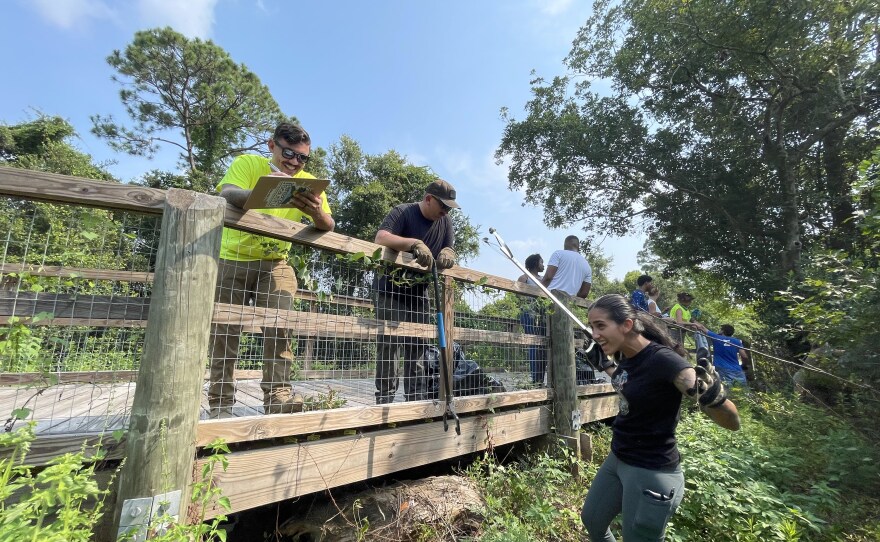The Trash Free Waters Project by the Pensacola & Perdido Bays Estuary Program kicked off Saturday at Jones Creek. Amid temperatures that felt like 100-degrees, 47 volunteers came together to pick up and record nearly 326 pounds of trash and launch a litter-capture boom into the creek.
Whitney Schefel, senior scientist for the Estuary Program, explains the functions of the litter-capture boom.
“A boom is almost like a capture net, so it will attach to either side of the creek. Then, when water flows down the creek, it will capture (litter) into the net. The main goal of this project is to remediate the trash that is in the waterway.”
The launch of the boom is the first of many endeavors of the project funded by a grant from the Environmental Protection Agency.
Schefel says the boom doesn’t just stop at litter capture, it will allow for data capture in order to track and find the source of the litter.
“We will have regular monitoring for this. So we will be numerating what is in the net, and we will also be capturing the different types of litter that we get in the creek.”
Once the primary sources of litter are discovered, the team will work to create change in community waste disposal.
“Then we hope to involve businesses and other community organizations to really start to dig into the root cause of where the trash is coming from and whether or not we can eliminate it from the source. Reducing the amount of plastic we use in general is really the way to go.”
Following the launch of the litter capture boom, volunteers from Keep Pensacola Beautiful, Ocean Hour, Keep Pensacola Beautiful, Visit Pensacola, Warrington Revitalization Committee, and Escambia County, cleaned up the Jones Creek area and carefully documented and tracked each piece of litter they collected.
Don Bates is owner and founder of Osprey Initiative, which provided the litter capture boom, and he elaborated on the types of litter being cleaned.
“Typically we are dealing with single-use plastics, aluminum cans, basic what you would find in litter.”
Although most litter falls into these basic categories, Bates shared that they sometimes find far more peculiar objects.
“Occasionally you get the weird stuff. Anything that floats will become litter. A possum that has been in the water for a while, you’ll think a zombie is under the water, They’ll freak you out a bit. Our wildest thing we found was a crematory urn. Baby dolls — the weirdest baby dolls. A lot of weird stuff.”
Bates emphasized that the work done to clean litter inland means less litter downstream.
“What people need to understand is all surface litter, in a parking lot or whatever, is coming to our oceans. Stormwater carrying litter goes through open pipes, from the small creeks to the big creeks, and out to the Gulf of Mexico. Any piece of litter you see on the ground is coming to our water.”
Bates noted that the Trash Free Waters Project shows a change in public attitude toward environmental protection.
“The beauty of everything here today is the protection and enhancement of our urban waterways. We have lost our connection to nature because we live in cities. There is a huge renaissance of protecting our urban waterways.”
Schefel says litter can be ingested and cause health issues for wildlife, or become dangerous entanglement hazards.
“A lot of people have seen pictures and videos of plastic being ingested by birds and turtles and other wildlife. Sometimes it looks like food to them.”
Not only does waterborne trash impact wildlife, but Schefel says it impacts humans as well as it infiltrates the water and food webs.
“It also breaks down into little pieces called microplastics which can be in our water, drinking water potentially, which can, of course, cause issues in the long run.”
Emerson Cheney, a volunteer coordinator with Pensacola & Perdido Bays Estuary Program, emphasized the vast scale at which plastic enters our oceans.
“I wish people knew what actions upstream impact the things we all value and cherish. Almost eight million tons of plastics leak into the oceans every year. That is only growing. A lot of that stuff comes from inland sources.”
Changing our daily habits is a key component of reducing plastic litter.
“Reducing and limiting the amount of plastic we come into contact with. Whether it means not taking the disposable bags at the grocery store, or choosing products that limit plastic packaging, all of those things go a really long way. Individually, we can make a lot of changes together.”
Those choices we make each day as individuals can add up to create large-scale change in our environment.
Another great way to get involved is to volunteer some of your time to picking up trash and litter from your local environment. Cheney encourages this and says more help is always needed.
“We are always looking for volunteers.”
Ultimately, the goal of the Trash Free Waters project is to prevent such litter from becoming waterborne in the first place.
Check out the Pensacola & Perdido Bays Estuary Program at ppbep.org and to support the monitoring of the litter capture boom contact Cheney at edcheney@ppbep.org.









